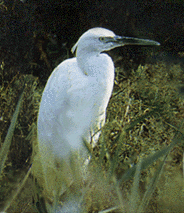...Best of Sicily
presents... Best of Sicily Magazine. ... Dedicated to Sicilian art, culture, history, people, places and all things Sicilian. |
by Vincenzo Mormino | ||
Magazine Index Best of Sicily Arts & Culture Fashion Food & Wine History & Society About Us Travel Faqs Contact Map of Sicily |
Its annual Winter passage through Sicily on the way to other southern regions is usually a brief one, but the egret, though a rare sight, is not invisible. It grows to a height of about sixty centimetres. Hardly "little," but true herons are much larger. Egretta thula, the snowy egret, is a New World species closely related, and remarkably similar, to the little egret, making this superspecies one of the world's most widespread birds. There are several subspecies, too. Then there are those bright yellow feet, certainly an unusual characteristic. The egret has been known to dip a foot in water and shake it about a bit to attract fish which it then catches with its long bill. A very efficient lure. It may not be entirely fitting to define as "Sicilian" a migratory bird such as the egret, but it has been known to nest in Sicily in the damp Winter months. Until the recent efforts to reclaim a few of Sicily's precious coastal marshlands, birds like the egret, seeing no inviting environment, usually chose Calabria, Apulia or Tunisia over Sicily. In the past, small inland swamps existed in some valleys, and migratory marsh birds found these inviting. The swamps were drained in the twentieth century in the interest of preventing malaria (though cures were introduced by the Americans in 1943); in the event many streams soon dried up with diminishing rainfall. Winter is the only time that any have enough water to satisfy the egret. Encouraging aristocratic honeymooners like the egret to vacation in Sicily is part of a noble effort that transcends tourism promotion. About the Author: Vincenzo Mormino is active in wildlife preservation throughout Sicily. He has written about the purple swamp hen and wild cat for previous issues. | |
Top of Page |
 The graceful bird is known as egretta garzetta to scientists, simply "garzetta" to Italians; it's the little egret to the rest of us. Related to the heron, this snowy white migratory bird lives in many parts of Eurasia and Africa, preferring marshes and other wetlands for feeding and breeding. It has a long black bill, black legs and bright yellow feet, and spends only part of its time in southeastern Sicily. There are far more pairs in certain regions of Spain, Portugal and Turkey, but little egrets are found as far north as Scandinavia and England. They feed on insects, frogs, small fish and reptiles.
The graceful bird is known as egretta garzetta to scientists, simply "garzetta" to Italians; it's the little egret to the rest of us. Related to the heron, this snowy white migratory bird lives in many parts of Eurasia and Africa, preferring marshes and other wetlands for feeding and breeding. It has a long black bill, black legs and bright yellow feet, and spends only part of its time in southeastern Sicily. There are far more pairs in certain regions of Spain, Portugal and Turkey, but little egrets are found as far north as Scandinavia and England. They feed on insects, frogs, small fish and reptiles.